3D Printing in Healthcare: Applications, Limitations, and Future
VerifiedAdded on 2023/06/12
|6
|2585
|71
AI Summary
This article discusses the current and future applications of 3D printing in healthcare, including its limitations and the need for enhanced imaging technology. The author explores the potential for 3D printing to create fully functioning organs and the challenges that must be overcome to achieve this goal.
Contribute Materials
Your contribution can guide someone’s learning journey. Share your
documents today.
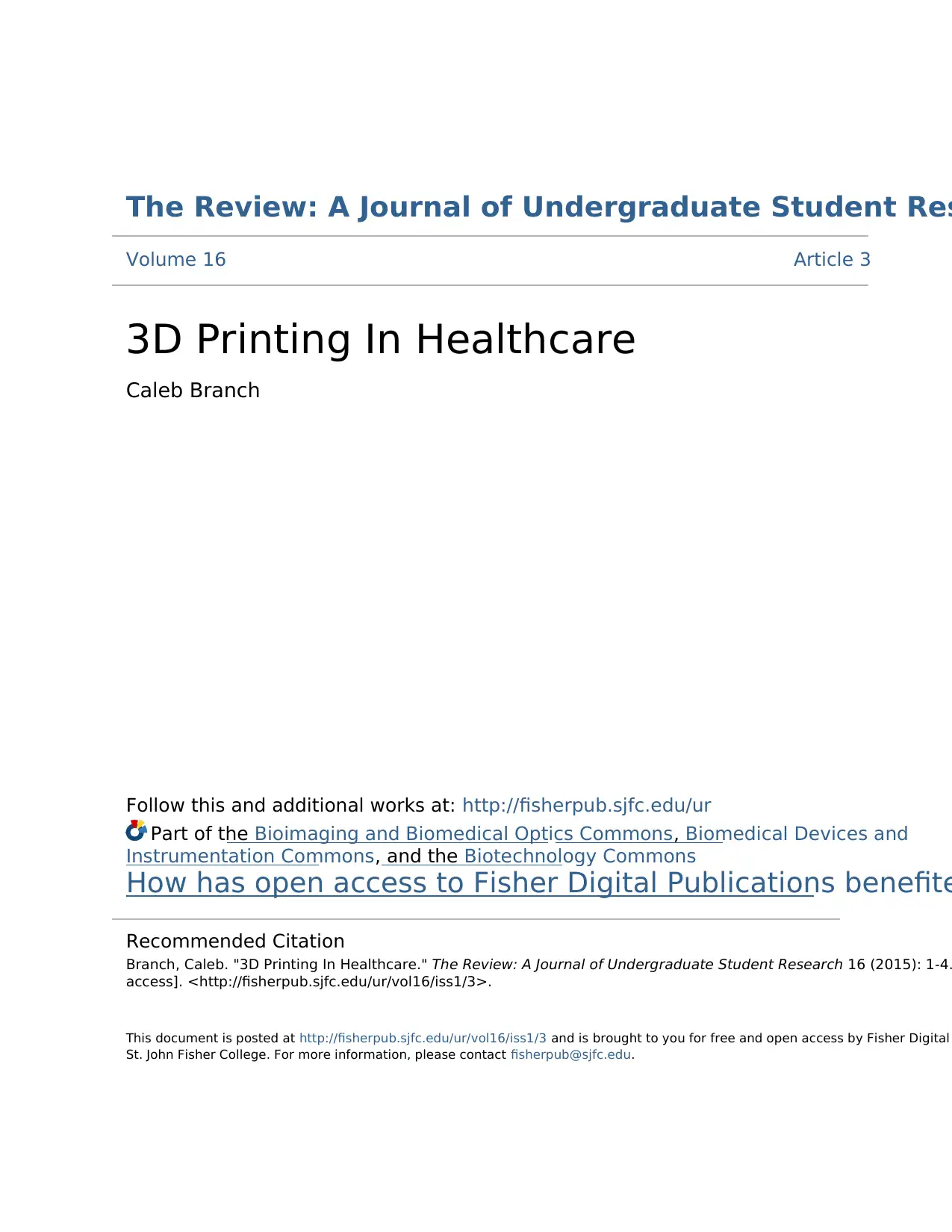
The Review: A Journal of Undergraduate Student Res
Volume 16 Article 3
3D Printing In Healthcare
Caleb Branch
Follow this and additional works at: http://fisherpub.sjfc.edu/ur
Part of the Bioimaging and Biomedical Optics Commons, Biomedical Devices and
Instrumentation Commons, and the Biotechnology Commons
How has open access to Fisher Digital Publications benefite
This document is posted at http://fisherpub.sjfc.edu/ur/vol16/iss1/3 and is brought to you for free and open access by Fisher Digital
St. John Fisher College. For more information, please contact fisherpub@sjfc.edu.
Recommended Citation
Branch, Caleb. "3D Printing In Healthcare." The Review: A Journal of Undergraduate Student Research 16 (2015): 1-4.
access]. <http://fisherpub.sjfc.edu/ur/vol16/iss1/3>.
Volume 16 Article 3
3D Printing In Healthcare
Caleb Branch
Follow this and additional works at: http://fisherpub.sjfc.edu/ur
Part of the Bioimaging and Biomedical Optics Commons, Biomedical Devices and
Instrumentation Commons, and the Biotechnology Commons
How has open access to Fisher Digital Publications benefite
This document is posted at http://fisherpub.sjfc.edu/ur/vol16/iss1/3 and is brought to you for free and open access by Fisher Digital
St. John Fisher College. For more information, please contact fisherpub@sjfc.edu.
Recommended Citation
Branch, Caleb. "3D Printing In Healthcare." The Review: A Journal of Undergraduate Student Research 16 (2015): 1-4.
access]. <http://fisherpub.sjfc.edu/ur/vol16/iss1/3>.
Secure Best Marks with AI Grader
Need help grading? Try our AI Grader for instant feedback on your assignments.
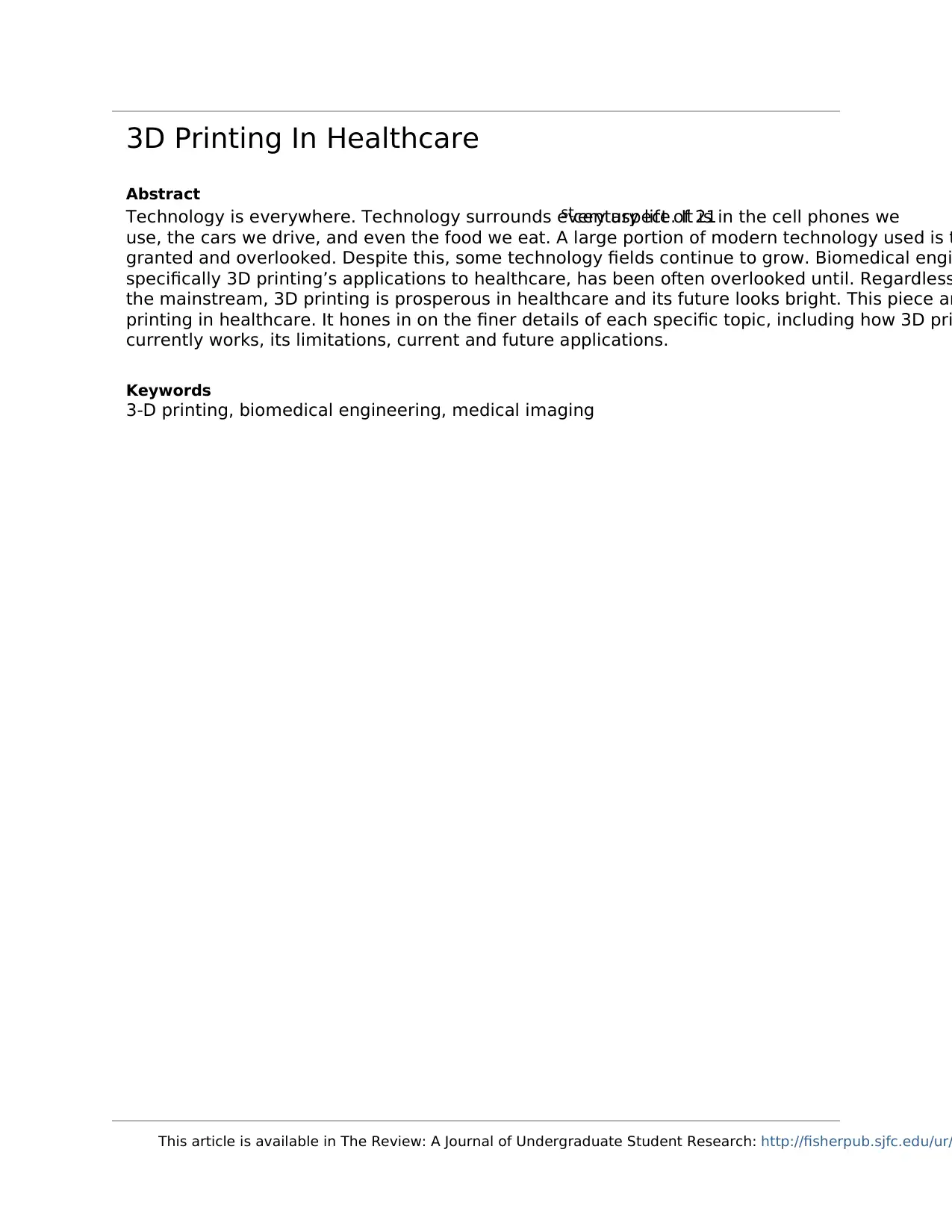
3D Printing In Healthcare
Abstract
Technology is everywhere. Technology surrounds every aspect of 21stcentury life. It is in the cell phones we
use, the cars we drive, and even the food we eat. A large portion of modern technology used is t
granted and overlooked. Despite this, some technology fields continue to grow. Biomedical engi
specifically 3D printing’s applications to healthcare, has been often overlooked until. Regardless
the mainstream, 3D printing is prosperous in healthcare and its future looks bright. This piece an
printing in healthcare. It hones in on the finer details of each specific topic, including how 3D pri
currently works, its limitations, current and future applications.
Keywords
3-D printing, biomedical engineering, medical imaging
This article is available in The Review: A Journal of Undergraduate Student Research: http://fisherpub.sjfc.edu/ur/
Abstract
Technology is everywhere. Technology surrounds every aspect of 21stcentury life. It is in the cell phones we
use, the cars we drive, and even the food we eat. A large portion of modern technology used is t
granted and overlooked. Despite this, some technology fields continue to grow. Biomedical engi
specifically 3D printing’s applications to healthcare, has been often overlooked until. Regardless
the mainstream, 3D printing is prosperous in healthcare and its future looks bright. This piece an
printing in healthcare. It hones in on the finer details of each specific topic, including how 3D pri
currently works, its limitations, current and future applications.
Keywords
3-D printing, biomedical engineering, medical imaging
This article is available in The Review: A Journal of Undergraduate Student Research: http://fisherpub.sjfc.edu/ur/
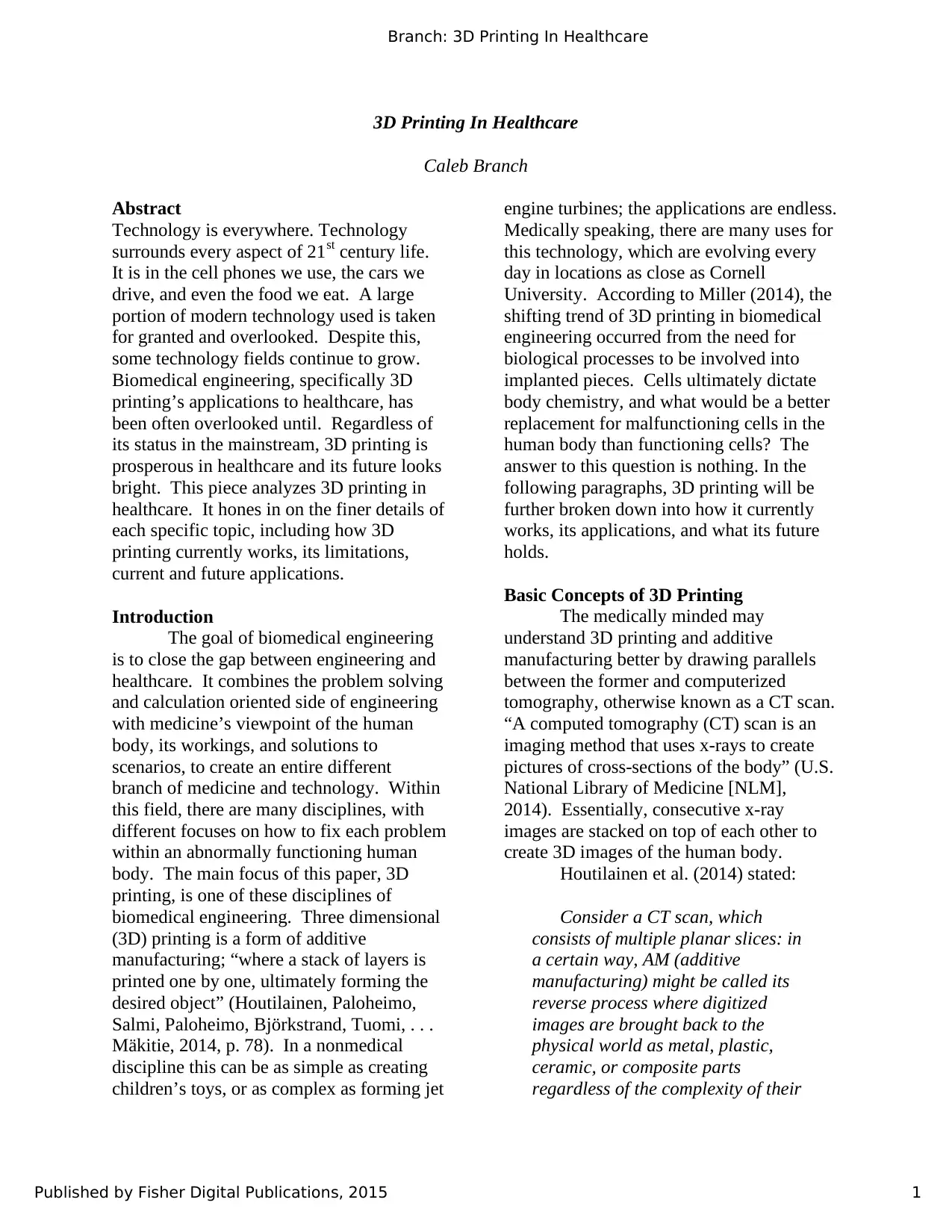
3D Printing In Healthcare
Caleb Branch
Abstract
Technology is everywhere. Technology
surrounds every aspect of 21st century life.
It is in the cell phones we use, the cars we
drive, and even the food we eat. A large
portion of modern technology used is taken
for granted and overlooked. Despite this,
some technology fields continue to grow.
Biomedical engineering, specifically 3D
printing’s applications to healthcare, has
been often overlooked until. Regardless of
its status in the mainstream, 3D printing is
prosperous in healthcare and its future looks
bright. This piece analyzes 3D printing in
healthcare. It hones in on the finer details of
each specific topic, including how 3D
printing currently works, its limitations,
current and future applications.
Introduction
The goal of biomedical engineering
is to close the gap between engineering and
healthcare. It combines the problem solving
and calculation oriented side of engineering
with medicine’s viewpoint of the human
body, its workings, and solutions to
scenarios, to create an entire different
branch of medicine and technology. Within
this field, there are many disciplines, with
different focuses on how to fix each problem
within an abnormally functioning human
body. The main focus of this paper, 3D
printing, is one of these disciplines of
biomedical engineering. Three dimensional
(3D) printing is a form of additive
manufacturing; “where a stack of layers is
printed one by one, ultimately forming the
desired object” (Houtilainen, Paloheimo,
Salmi, Paloheimo, Björkstrand, Tuomi, . . .
Mäkitie, 2014, p. 78). In a nonmedical
discipline this can be as simple as creating
children’s toys, or as complex as forming jet
engine turbines; the applications are endless.
Medically speaking, there are many uses for
this technology, which are evolving every
day in locations as close as Cornell
University. According to Miller (2014), the
shifting trend of 3D printing in biomedical
engineering occurred from the need for
biological processes to be involved into
implanted pieces. Cells ultimately dictate
body chemistry, and what would be a better
replacement for malfunctioning cells in the
human body than functioning cells? The
answer to this question is nothing. In the
following paragraphs, 3D printing will be
further broken down into how it currently
works, its applications, and what its future
holds.
Basic Concepts of 3D Printing
The medically minded may
understand 3D printing and additive
manufacturing better by drawing parallels
between the former and computerized
tomography, otherwise known as a CT scan.
“A computed tomography (CT) scan is an
imaging method that uses x-rays to create
pictures of cross-sections of the body” (U.S.
National Library of Medicine [NLM],
2014). Essentially, consecutive x-ray
images are stacked on top of each other to
create 3D images of the human body.
Houtilainen et al. (2014) stated:
Consider a CT scan, which
consists of multiple planar slices: in
a certain way, AM (additive
manufacturing) might be called its
reverse process where digitized
images are brought back to the
physical world as metal, plastic,
ceramic, or composite parts
regardless of the complexity of their
1
Branch: 3D Printing In Healthcare
Published by Fisher Digital Publications, 2015
Caleb Branch
Abstract
Technology is everywhere. Technology
surrounds every aspect of 21st century life.
It is in the cell phones we use, the cars we
drive, and even the food we eat. A large
portion of modern technology used is taken
for granted and overlooked. Despite this,
some technology fields continue to grow.
Biomedical engineering, specifically 3D
printing’s applications to healthcare, has
been often overlooked until. Regardless of
its status in the mainstream, 3D printing is
prosperous in healthcare and its future looks
bright. This piece analyzes 3D printing in
healthcare. It hones in on the finer details of
each specific topic, including how 3D
printing currently works, its limitations,
current and future applications.
Introduction
The goal of biomedical engineering
is to close the gap between engineering and
healthcare. It combines the problem solving
and calculation oriented side of engineering
with medicine’s viewpoint of the human
body, its workings, and solutions to
scenarios, to create an entire different
branch of medicine and technology. Within
this field, there are many disciplines, with
different focuses on how to fix each problem
within an abnormally functioning human
body. The main focus of this paper, 3D
printing, is one of these disciplines of
biomedical engineering. Three dimensional
(3D) printing is a form of additive
manufacturing; “where a stack of layers is
printed one by one, ultimately forming the
desired object” (Houtilainen, Paloheimo,
Salmi, Paloheimo, Björkstrand, Tuomi, . . .
Mäkitie, 2014, p. 78). In a nonmedical
discipline this can be as simple as creating
children’s toys, or as complex as forming jet
engine turbines; the applications are endless.
Medically speaking, there are many uses for
this technology, which are evolving every
day in locations as close as Cornell
University. According to Miller (2014), the
shifting trend of 3D printing in biomedical
engineering occurred from the need for
biological processes to be involved into
implanted pieces. Cells ultimately dictate
body chemistry, and what would be a better
replacement for malfunctioning cells in the
human body than functioning cells? The
answer to this question is nothing. In the
following paragraphs, 3D printing will be
further broken down into how it currently
works, its applications, and what its future
holds.
Basic Concepts of 3D Printing
The medically minded may
understand 3D printing and additive
manufacturing better by drawing parallels
between the former and computerized
tomography, otherwise known as a CT scan.
“A computed tomography (CT) scan is an
imaging method that uses x-rays to create
pictures of cross-sections of the body” (U.S.
National Library of Medicine [NLM],
2014). Essentially, consecutive x-ray
images are stacked on top of each other to
create 3D images of the human body.
Houtilainen et al. (2014) stated:
Consider a CT scan, which
consists of multiple planar slices: in
a certain way, AM (additive
manufacturing) might be called its
reverse process where digitized
images are brought back to the
physical world as metal, plastic,
ceramic, or composite parts
regardless of the complexity of their
1
Branch: 3D Printing In Healthcare
Published by Fisher Digital Publications, 2015
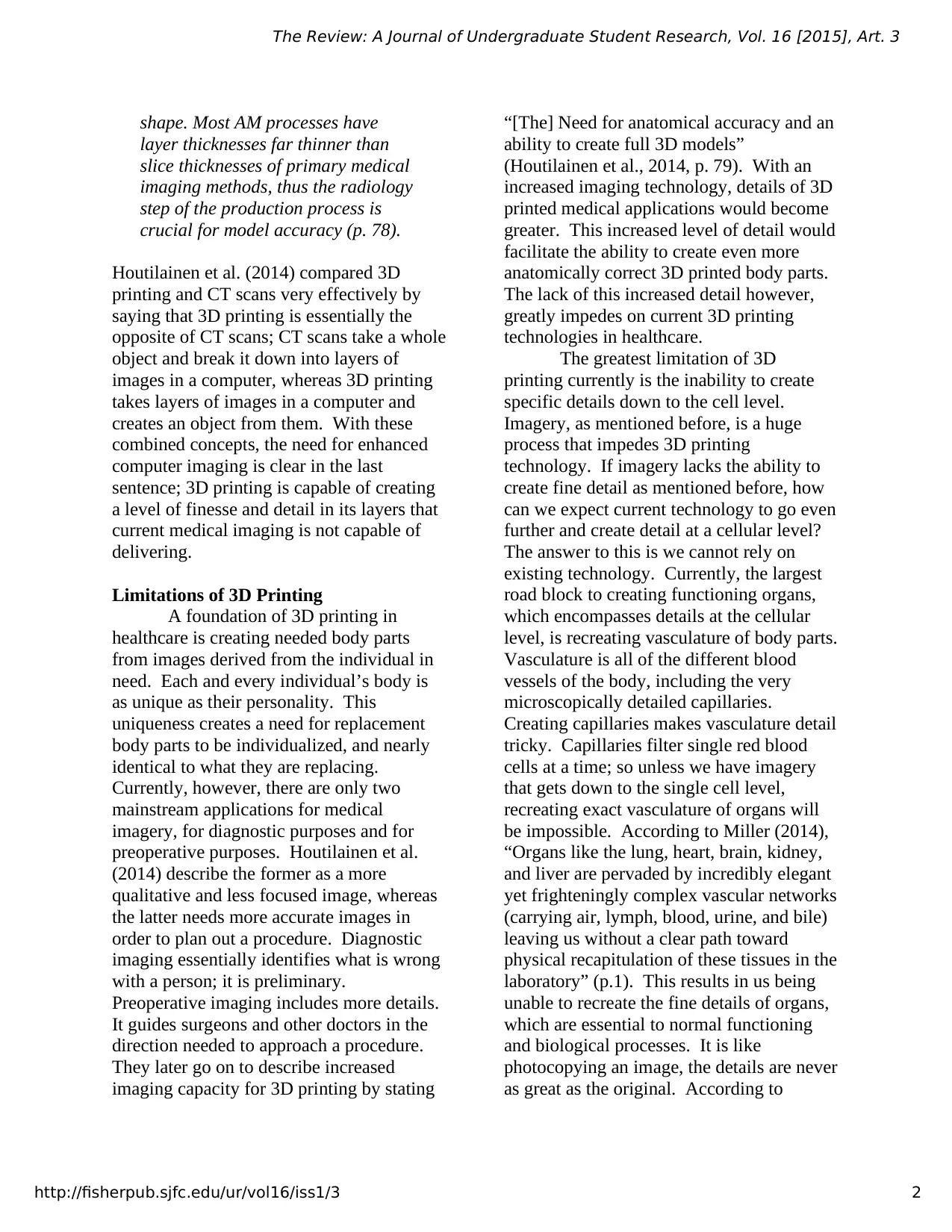
shape. Most AM processes have
layer thicknesses far thinner than
slice thicknesses of primary medical
imaging methods, thus the radiology
step of the production process is
crucial for model accuracy (p. 78).
Houtilainen et al. (2014) compared 3D
printing and CT scans very effectively by
saying that 3D printing is essentially the
opposite of CT scans; CT scans take a whole
object and break it down into layers of
images in a computer, whereas 3D printing
takes layers of images in a computer and
creates an object from them. With these
combined concepts, the need for enhanced
computer imaging is clear in the last
sentence; 3D printing is capable of creating
a level of finesse and detail in its layers that
current medical imaging is not capable of
delivering.
Limitations of 3D Printing
A foundation of 3D printing in
healthcare is creating needed body parts
from images derived from the individual in
need. Each and every individual’s body is
as unique as their personality. This
uniqueness creates a need for replacement
body parts to be individualized, and nearly
identical to what they are replacing.
Currently, however, there are only two
mainstream applications for medical
imagery, for diagnostic purposes and for
preoperative purposes. Houtilainen et al.
(2014) describe the former as a more
qualitative and less focused image, whereas
the latter needs more accurate images in
order to plan out a procedure. Diagnostic
imaging essentially identifies what is wrong
with a person; it is preliminary.
Preoperative imaging includes more details.
It guides surgeons and other doctors in the
direction needed to approach a procedure.
They later go on to describe increased
imaging capacity for 3D printing by stating
“[The] Need for anatomical accuracy and an
ability to create full 3D models”
(Houtilainen et al., 2014, p. 79). With an
increased imaging technology, details of 3D
printed medical applications would become
greater. This increased level of detail would
facilitate the ability to create even more
anatomically correct 3D printed body parts.
The lack of this increased detail however,
greatly impedes on current 3D printing
technologies in healthcare.
The greatest limitation of 3D
printing currently is the inability to create
specific details down to the cell level.
Imagery, as mentioned before, is a huge
process that impedes 3D printing
technology. If imagery lacks the ability to
create fine detail as mentioned before, how
can we expect current technology to go even
further and create detail at a cellular level?
The answer to this is we cannot rely on
existing technology. Currently, the largest
road block to creating functioning organs,
which encompasses details at the cellular
level, is recreating vasculature of body parts.
Vasculature is all of the different blood
vessels of the body, including the very
microscopically detailed capillaries.
Creating capillaries makes vasculature detail
tricky. Capillaries filter single red blood
cells at a time; so unless we have imagery
that gets down to the single cell level,
recreating exact vasculature of organs will
be impossible. According to Miller (2014),
“Organs like the lung, heart, brain, kidney,
and liver are pervaded by incredibly elegant
yet frighteningly complex vascular networks
(carrying air, lymph, blood, urine, and bile)
leaving us without a clear path toward
physical recapitulation of these tissues in the
laboratory” (p.1). This results in us being
unable to recreate the fine details of organs,
which are essential to normal functioning
and biological processes. It is like
photocopying an image, the details are never
as great as the original. According to
2
The Review: A Journal of Undergraduate Student Research, Vol. 16 [2015], Art. 3
http://fisherpub.sjfc.edu/ur/vol16/iss1/3
layer thicknesses far thinner than
slice thicknesses of primary medical
imaging methods, thus the radiology
step of the production process is
crucial for model accuracy (p. 78).
Houtilainen et al. (2014) compared 3D
printing and CT scans very effectively by
saying that 3D printing is essentially the
opposite of CT scans; CT scans take a whole
object and break it down into layers of
images in a computer, whereas 3D printing
takes layers of images in a computer and
creates an object from them. With these
combined concepts, the need for enhanced
computer imaging is clear in the last
sentence; 3D printing is capable of creating
a level of finesse and detail in its layers that
current medical imaging is not capable of
delivering.
Limitations of 3D Printing
A foundation of 3D printing in
healthcare is creating needed body parts
from images derived from the individual in
need. Each and every individual’s body is
as unique as their personality. This
uniqueness creates a need for replacement
body parts to be individualized, and nearly
identical to what they are replacing.
Currently, however, there are only two
mainstream applications for medical
imagery, for diagnostic purposes and for
preoperative purposes. Houtilainen et al.
(2014) describe the former as a more
qualitative and less focused image, whereas
the latter needs more accurate images in
order to plan out a procedure. Diagnostic
imaging essentially identifies what is wrong
with a person; it is preliminary.
Preoperative imaging includes more details.
It guides surgeons and other doctors in the
direction needed to approach a procedure.
They later go on to describe increased
imaging capacity for 3D printing by stating
“[The] Need for anatomical accuracy and an
ability to create full 3D models”
(Houtilainen et al., 2014, p. 79). With an
increased imaging technology, details of 3D
printed medical applications would become
greater. This increased level of detail would
facilitate the ability to create even more
anatomically correct 3D printed body parts.
The lack of this increased detail however,
greatly impedes on current 3D printing
technologies in healthcare.
The greatest limitation of 3D
printing currently is the inability to create
specific details down to the cell level.
Imagery, as mentioned before, is a huge
process that impedes 3D printing
technology. If imagery lacks the ability to
create fine detail as mentioned before, how
can we expect current technology to go even
further and create detail at a cellular level?
The answer to this is we cannot rely on
existing technology. Currently, the largest
road block to creating functioning organs,
which encompasses details at the cellular
level, is recreating vasculature of body parts.
Vasculature is all of the different blood
vessels of the body, including the very
microscopically detailed capillaries.
Creating capillaries makes vasculature detail
tricky. Capillaries filter single red blood
cells at a time; so unless we have imagery
that gets down to the single cell level,
recreating exact vasculature of organs will
be impossible. According to Miller (2014),
“Organs like the lung, heart, brain, kidney,
and liver are pervaded by incredibly elegant
yet frighteningly complex vascular networks
(carrying air, lymph, blood, urine, and bile)
leaving us without a clear path toward
physical recapitulation of these tissues in the
laboratory” (p.1). This results in us being
unable to recreate the fine details of organs,
which are essential to normal functioning
and biological processes. It is like
photocopying an image, the details are never
as great as the original. According to
2
The Review: A Journal of Undergraduate Student Research, Vol. 16 [2015], Art. 3
http://fisherpub.sjfc.edu/ur/vol16/iss1/3
Secure Best Marks with AI Grader
Need help grading? Try our AI Grader for instant feedback on your assignments.
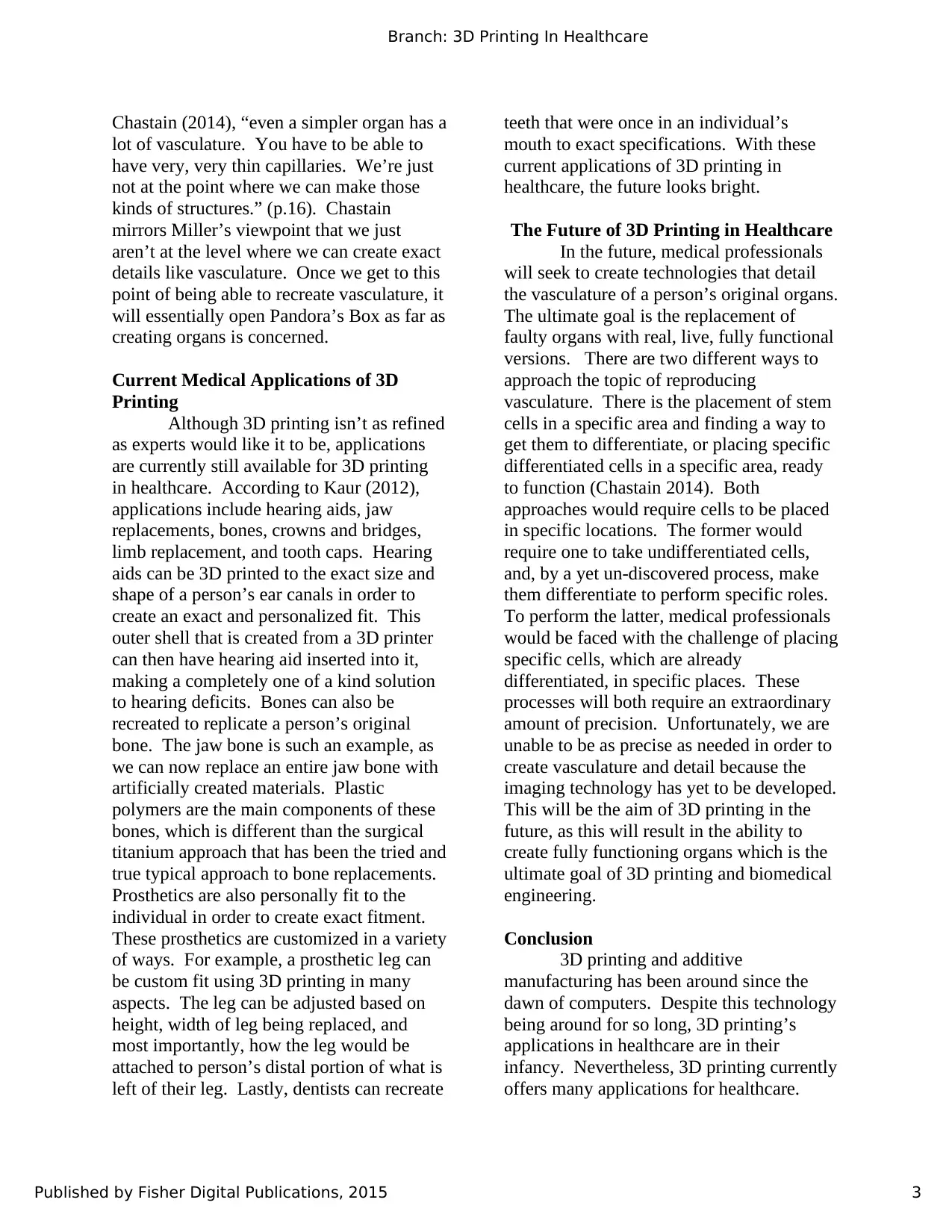
Chastain (2014), “even a simpler organ has a
lot of vasculature. You have to be able to
have very, very thin capillaries. We’re just
not at the point where we can make those
kinds of structures.” (p.16). Chastain
mirrors Miller’s viewpoint that we just
aren’t at the level where we can create exact
details like vasculature. Once we get to this
point of being able to recreate vasculature, it
will essentially open Pandora’s Box as far as
creating organs is concerned.
Current Medical Applications of 3D
Printing
Although 3D printing isn’t as refined
as experts would like it to be, applications
are currently still available for 3D printing
in healthcare. According to Kaur (2012),
applications include hearing aids, jaw
replacements, bones, crowns and bridges,
limb replacement, and tooth caps. Hearing
aids can be 3D printed to the exact size and
shape of a person’s ear canals in order to
create an exact and personalized fit. This
outer shell that is created from a 3D printer
can then have hearing aid inserted into it,
making a completely one of a kind solution
to hearing deficits. Bones can also be
recreated to replicate a person’s original
bone. The jaw bone is such an example, as
we can now replace an entire jaw bone with
artificially created materials. Plastic
polymers are the main components of these
bones, which is different than the surgical
titanium approach that has been the tried and
true typical approach to bone replacements.
Prosthetics are also personally fit to the
individual in order to create exact fitment.
These prosthetics are customized in a variety
of ways. For example, a prosthetic leg can
be custom fit using 3D printing in many
aspects. The leg can be adjusted based on
height, width of leg being replaced, and
most importantly, how the leg would be
attached to person’s distal portion of what is
left of their leg. Lastly, dentists can recreate
teeth that were once in an individual’s
mouth to exact specifications. With these
current applications of 3D printing in
healthcare, the future looks bright.
The Future of 3D Printing in Healthcare
In the future, medical professionals
will seek to create technologies that detail
the vasculature of a person’s original organs.
The ultimate goal is the replacement of
faulty organs with real, live, fully functional
versions. There are two different ways to
approach the topic of reproducing
vasculature. There is the placement of stem
cells in a specific area and finding a way to
get them to differentiate, or placing specific
differentiated cells in a specific area, ready
to function (Chastain 2014). Both
approaches would require cells to be placed
in specific locations. The former would
require one to take undifferentiated cells,
and, by a yet un-discovered process, make
them differentiate to perform specific roles.
To perform the latter, medical professionals
would be faced with the challenge of placing
specific cells, which are already
differentiated, in specific places. These
processes will both require an extraordinary
amount of precision. Unfortunately, we are
unable to be as precise as needed in order to
create vasculature and detail because the
imaging technology has yet to be developed.
This will be the aim of 3D printing in the
future, as this will result in the ability to
create fully functioning organs which is the
ultimate goal of 3D printing and biomedical
engineering.
Conclusion
3D printing and additive
manufacturing has been around since the
dawn of computers. Despite this technology
being around for so long, 3D printing’s
applications in healthcare are in their
infancy. Nevertheless, 3D printing currently
offers many applications for healthcare.
3
Branch: 3D Printing In Healthcare
Published by Fisher Digital Publications, 2015
lot of vasculature. You have to be able to
have very, very thin capillaries. We’re just
not at the point where we can make those
kinds of structures.” (p.16). Chastain
mirrors Miller’s viewpoint that we just
aren’t at the level where we can create exact
details like vasculature. Once we get to this
point of being able to recreate vasculature, it
will essentially open Pandora’s Box as far as
creating organs is concerned.
Current Medical Applications of 3D
Printing
Although 3D printing isn’t as refined
as experts would like it to be, applications
are currently still available for 3D printing
in healthcare. According to Kaur (2012),
applications include hearing aids, jaw
replacements, bones, crowns and bridges,
limb replacement, and tooth caps. Hearing
aids can be 3D printed to the exact size and
shape of a person’s ear canals in order to
create an exact and personalized fit. This
outer shell that is created from a 3D printer
can then have hearing aid inserted into it,
making a completely one of a kind solution
to hearing deficits. Bones can also be
recreated to replicate a person’s original
bone. The jaw bone is such an example, as
we can now replace an entire jaw bone with
artificially created materials. Plastic
polymers are the main components of these
bones, which is different than the surgical
titanium approach that has been the tried and
true typical approach to bone replacements.
Prosthetics are also personally fit to the
individual in order to create exact fitment.
These prosthetics are customized in a variety
of ways. For example, a prosthetic leg can
be custom fit using 3D printing in many
aspects. The leg can be adjusted based on
height, width of leg being replaced, and
most importantly, how the leg would be
attached to person’s distal portion of what is
left of their leg. Lastly, dentists can recreate
teeth that were once in an individual’s
mouth to exact specifications. With these
current applications of 3D printing in
healthcare, the future looks bright.
The Future of 3D Printing in Healthcare
In the future, medical professionals
will seek to create technologies that detail
the vasculature of a person’s original organs.
The ultimate goal is the replacement of
faulty organs with real, live, fully functional
versions. There are two different ways to
approach the topic of reproducing
vasculature. There is the placement of stem
cells in a specific area and finding a way to
get them to differentiate, or placing specific
differentiated cells in a specific area, ready
to function (Chastain 2014). Both
approaches would require cells to be placed
in specific locations. The former would
require one to take undifferentiated cells,
and, by a yet un-discovered process, make
them differentiate to perform specific roles.
To perform the latter, medical professionals
would be faced with the challenge of placing
specific cells, which are already
differentiated, in specific places. These
processes will both require an extraordinary
amount of precision. Unfortunately, we are
unable to be as precise as needed in order to
create vasculature and detail because the
imaging technology has yet to be developed.
This will be the aim of 3D printing in the
future, as this will result in the ability to
create fully functioning organs which is the
ultimate goal of 3D printing and biomedical
engineering.
Conclusion
3D printing and additive
manufacturing has been around since the
dawn of computers. Despite this technology
being around for so long, 3D printing’s
applications in healthcare are in their
infancy. Nevertheless, 3D printing currently
offers many applications for healthcare.
3
Branch: 3D Printing In Healthcare
Published by Fisher Digital Publications, 2015
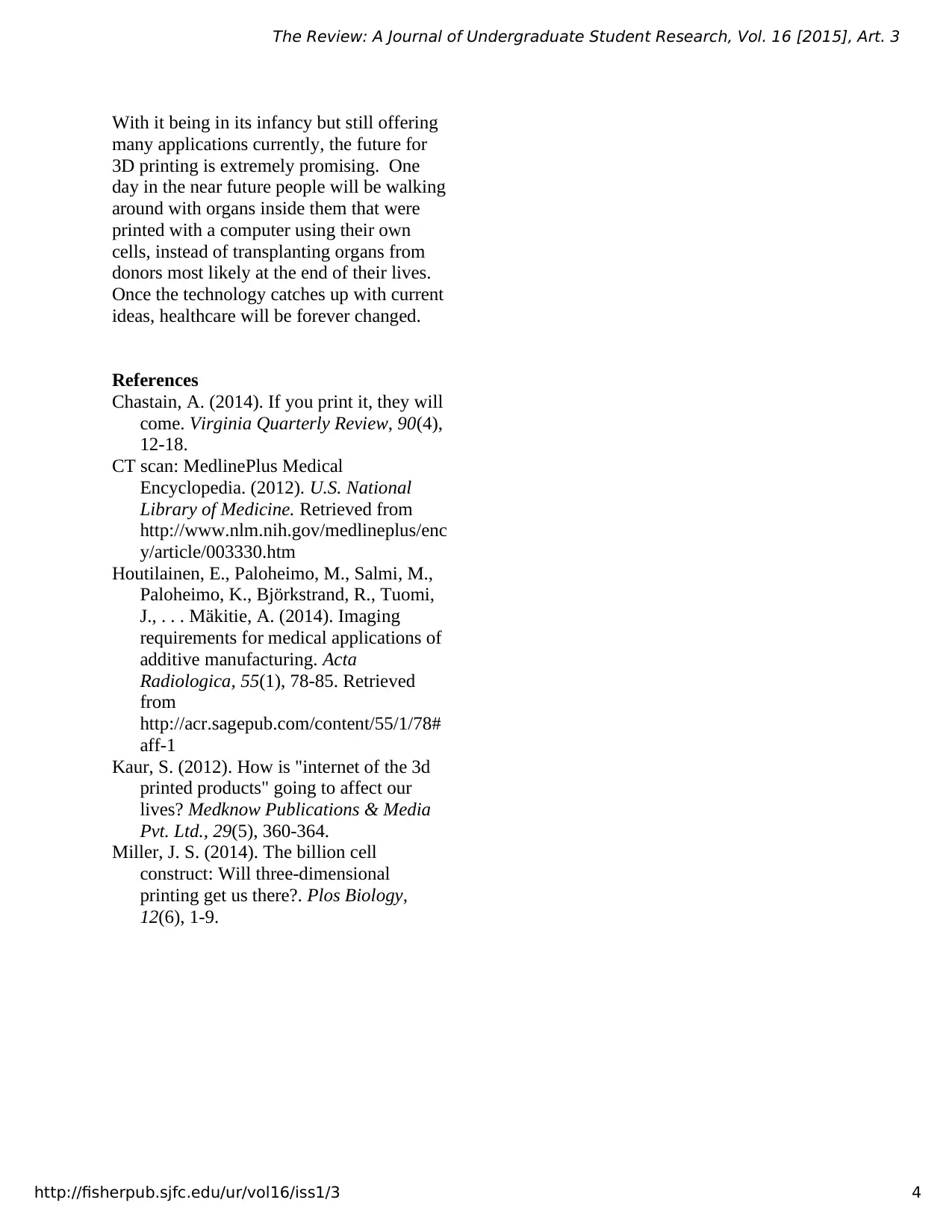
With it being in its infancy but still offering
many applications currently, the future for
3D printing is extremely promising. One
day in the near future people will be walking
around with organs inside them that were
printed with a computer using their own
cells, instead of transplanting organs from
donors most likely at the end of their lives.
Once the technology catches up with current
ideas, healthcare will be forever changed.
References
Chastain, A. (2014). If you print it, they will
come. Virginia Quarterly Review, 90(4),
12-18.
CT scan: MedlinePlus Medical
Encyclopedia. (2012). U.S. National
Library of Medicine. Retrieved from
http://www.nlm.nih.gov/medlineplus/enc
y/article/003330.htm
Houtilainen, E., Paloheimo, M., Salmi, M.,
Paloheimo, K., Björkstrand, R., Tuomi,
J., . . . Mäkitie, A. (2014). Imaging
requirements for medical applications of
additive manufacturing. Acta
Radiologica, 55(1), 78-85. Retrieved
from
http://acr.sagepub.com/content/55/1/78#
aff-1
Kaur, S. (2012). How is "internet of the 3d
printed products" going to affect our
lives? Medknow Publications & Media
Pvt. Ltd., 29(5), 360-364.
Miller, J. S. (2014). The billion cell
construct: Will three-dimensional
printing get us there?. Plos Biology,
12(6), 1-9.
4
The Review: A Journal of Undergraduate Student Research, Vol. 16 [2015], Art. 3
http://fisherpub.sjfc.edu/ur/vol16/iss1/3
many applications currently, the future for
3D printing is extremely promising. One
day in the near future people will be walking
around with organs inside them that were
printed with a computer using their own
cells, instead of transplanting organs from
donors most likely at the end of their lives.
Once the technology catches up with current
ideas, healthcare will be forever changed.
References
Chastain, A. (2014). If you print it, they will
come. Virginia Quarterly Review, 90(4),
12-18.
CT scan: MedlinePlus Medical
Encyclopedia. (2012). U.S. National
Library of Medicine. Retrieved from
http://www.nlm.nih.gov/medlineplus/enc
y/article/003330.htm
Houtilainen, E., Paloheimo, M., Salmi, M.,
Paloheimo, K., Björkstrand, R., Tuomi,
J., . . . Mäkitie, A. (2014). Imaging
requirements for medical applications of
additive manufacturing. Acta
Radiologica, 55(1), 78-85. Retrieved
from
http://acr.sagepub.com/content/55/1/78#
aff-1
Kaur, S. (2012). How is "internet of the 3d
printed products" going to affect our
lives? Medknow Publications & Media
Pvt. Ltd., 29(5), 360-364.
Miller, J. S. (2014). The billion cell
construct: Will three-dimensional
printing get us there?. Plos Biology,
12(6), 1-9.
4
The Review: A Journal of Undergraduate Student Research, Vol. 16 [2015], Art. 3
http://fisherpub.sjfc.edu/ur/vol16/iss1/3
1 out of 6
Your All-in-One AI-Powered Toolkit for Academic Success.
+13062052269
info@desklib.com
Available 24*7 on WhatsApp / Email
![[object Object]](/_next/static/media/star-bottom.7253800d.svg)
Unlock your academic potential
© 2024 | Zucol Services PVT LTD | All rights reserved.